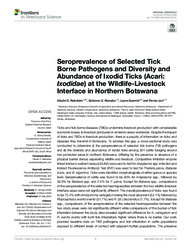| dc.contributor.author | Raboloko, Obuile O. | |
| dc.contributor.author | Ramabu, Solomon S. | |
| dc.contributor.author | Guerrini, Laure | |
| dc.contributor.author | Jori, Ferran | |
| dc.date.accessioned | 2021-11-16T13:00:41Z | |
| dc.date.available | 2021-11-16T13:00:41Z | |
| dc.date.issued | 2020-05-05 | |
| dc.identifier.citation | Raboloko, O. O., Ramabu, S. S., Guerrini, L., & Jori, F. (2020). Seroprevalence of selected tick borne pathogens and diversity and abundance of ixodid ticks (Acari: Ixodidae) at the wildlife-livestock interface in Northern Botswana. Frontiers in Veterinary Science, 7, 187. | en_US |
| dc.identifier.issn | 2297-1769 | |
| dc.identifier.uri | https://www.frontiersin.org/articles/10.3389/fvets.2020.00187/full | |
| dc.identifier.uri | http://researchhub.buan.ac.bw:80/handle/123456789/77 | |
| dc.description.abstract | Ticks and tick borne diseases (TBDs) undermine livestock production with considerable economic losses to livestock producers in endemic areas worldwide. Despite the impact of ticks and TBDs in livestock production, there is a paucity of information on ticks and diseases they transmit in Botswana. To address this gap, a cross-sectional study was conducted to determine (i) the seroprevalence of selected tick borne (TB) pathogens and (ii) the diversity and abundance of ixodid ticks among 301 cattle foraging around two protected areas in northern Botswana, differing by the presence or absence of a physical barrier (fence) separating wildlife and livestock. Competitive inhibition enzyme linked immuno-sorbent assay (cELISA) was used to test for Anaplasma spp. infection and Indirect Fluorescence Antibody Test (IFAT) was used to test for Theileria parva, Babesia bovis, and B. bigemina. Ticks were identified morphologically at either genus or species level. Seroprevalence of cattle was found to be 90% for Anaplasma spp., followed by 38.6% for Babesia spp. and 2.4% for T. parva. Except for Babesia spp., comparisons of the seroprevalence of the selected haemoparasites between the two wildlife-livestock interface areas were not significantly different. The overall prevalence of ticks was found to be 73.4% with Amblyomma variegatum being the most abundant (53.1%) followed by Rhipicephalus evertsi evertsi (31.7%) and R. (B.) decoloratus (7.7%). Except for Babesia spp., comparisons of the seroprevalence of the selected haemoparasites between the two study areas were not significantly different while comparisons of the burden of tick infestation between the study sites revealed significant difference for A. variegatum and R. evertsi evertsi with both tick infestations higher where there is no barrier. Our work provided baseline data on TBD pathogens and tick infestation in cattle populations exposed to different levels of contact with adjacent buffalo populations. The presence Raboloko et al. Tick Borne Diseases in Botswana of a veterinary fence did not significantly influence the seroprevalence of the selected TBD pathogens (except for Babesia spp.) but seemed to reduce tick burdens in cattle. Findings from this study can be used for guiding future epidemiological study designs to improve our understanding of ticks and TBDs dynamics in northern Botswana. | en_US |
| dc.language.iso | en | en_US |
| dc.publisher | Frontiers Media | en_US |
| dc.relation.ispartofseries | Frontiers in Veterinary Science;Vol. 7,187, 2020 | |
| dc.subject | Tick borne diseases | en_US |
| dc.subject | Anaplasma spp | en_US |
| dc.subject | Babesia spp | en_US |
| dc.subject | T. parva | en_US |
| dc.subject | Seroprevalence | en_US |
| dc.subject | Ticks | en_US |
| dc.subject | Veterinary fence | en_US |
| dc.subject | Botswana | en_US |
| dc.title | Seroprevalence of Selected Tick Borne Pathogens and Diversity and Abundance of Ixodid Ticks (Acari: Ixodidae) at the Wildlife-Livestock Interface in Northern Botswana | en_US |
| dc.type | Article | en_US |

